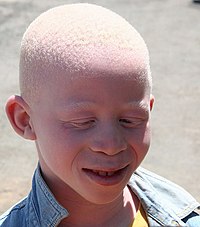
Photo from wikipedia
Oculocutaneous albinism (OCA) is a group of rare, inherited disorders associated with reduced melanin biosynthesis. Clinical manifestations of the eight known subtypes of OCA include hypopigmented skin, eyes, and hair… Click to show full abstract
Oculocutaneous albinism (OCA) is a group of rare, inherited disorders associated with reduced melanin biosynthesis. Clinical manifestations of the eight known subtypes of OCA include hypopigmented skin, eyes, and hair and ocular manifestations, such as decreased visual acuity and nystagmus. OCA affects people globally but is most prevalent in African countries. Individuals with oculocutaneous albinism lack UV protection and are prone to skin damage and skin cancers. For many African albino individuals, there are significant challenges in seeking treatment for skin cancer and preventing sun damage due to psychosocial factors and poor education. This review summarizes the current understanding of the epidemiology, genetics, and clinical manifestations of OCA. We also discuss the medical and psychosocial challenges that affect individuals with OCA and the current landscape of albinism treatment modalities. The extent of the psychosocial challenges needs to be better understood and additional educational interventions may improve quality of life for people with albinism.
Journal Title: Archives of Dermatological Research
Year Published: 2022
Link to full text (if available)
Share on Social Media: Sign Up to like & get
recommendations!